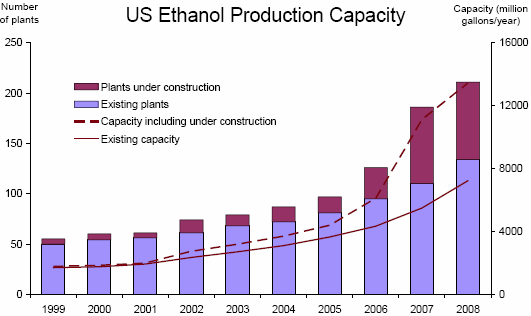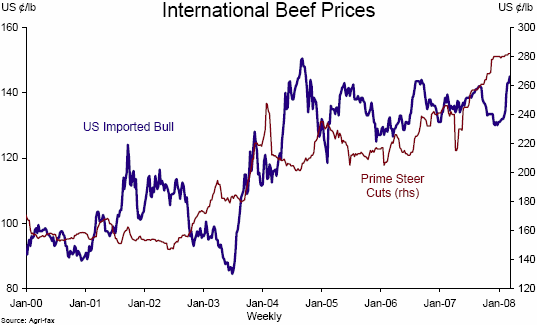



The Beef With Mandated Ethanol
By the Bank of New Zealand, published in the BNZ Commodities Wrap.- Ethanol policies skewer US cattle industry
- Feed costs through the roof; cattle numbers falling
- US manufactured beef kill to soar
- Significant risks to outlook for NZ beef returns
- Next 12 months – at least – likely to be a struggle
US cattle farmers are hurting. Profitability is being hammered by a combination of weak returns and soaring feed costs, leading an increasing number of farmers to reduce their herd numbers or leave the industry altogether. Such is confirmed by the latest cattle inventory data from the US Department of Agriculture (USDA), which shows that the US cattle herd is on the wane.
In the past, this scenario has been painted as providing a massive boost to New Zealand’s cattle farmers. And indeed, in time, it will. But in the shorterrun the environment for our beef exporters is likely to be considerably more rocky.

The relevance of developments in the US to New Zealand’s beef producers may not be immediately apparent, but the fact is that the US is a critical market. Fifty per cent of New Zealand’s beef exports head to the US, as low-grade manufacturing beef destined for the hamburger trade. New Zealand’s beef is truly a commodity product, undifferentiated from that of other suppliers, whether from competing imports or US farmers. So New Zealand exporters are price takers, with those prices effectively determined in the US market – and the outlook in that market, for the next several seasons at least, is not good.
The US beef industry is facing challenges on two fronts. The first is the weather: drought in key cattle rearing areas in the US over the past couple of years has forced farmers to cull cattle at rates well above normal. On its own, a drought in the US could normally be ridden out. A return to normal weather conditions would typically see herds rebuild, beef prices shift upwards and profitability resume.

But this return-to-normal scenario is being stymied by the US government’s decision to mandate increased ethanol production. Amongst other things, the Energy Policy Act 2005 (and more recently the Energy Independence and Security Act 2007) requires sharp increases, over the next decade, in the amount of biofuel (usually ethanol) that must be mixed with gasoline sold in the US. Ethanol producers are already receiving substantial tax credits as an incentive to lift production, and ethanol imports are subject to tariffs.
The impact of these biofuel policies has been huge. There are now 134 active ethanol plants in the US, from just 50 in 1999. Production capacity has more than quadrupled in that time. And there’s plenty more to come: plants currently under construction will see existing capacity lift by a further 85%. Future developments will obviously boost ethanol production still further.
But one of the (presumably unintended) side effects of the push into ethanol is that livestock feed costs have gone through the roof. Prices of corn, the primary feedstock for the bulk of ethanol production, have soared, helping to drag up the prices of all crops. Compounding these general crop price increases is the fact that US growers are quickly chasing the revenue from corn, favouring it over the much less lucrative grains that most US cattle farmers have traditionally relied on to feed their stock.
In effect, US cattle farmers (like many food producers) are competing with the bio-fuel industry for raw inputs. And with so much government support available for ethanol production, beef producers haven’t got a hope of competing on an equal footing.

The upshot is that soaring feed costs, in conjunction with only modest growth in beef prices in recent seasons, have seen precipitous declines in cattle farmers’ feed-price ratios (calculated as the ratio of returns to feed costs, so that a higher number is better).
All of which has seen the air of optimism surrounding the US beef industry, and international beef prices more generally, quickly evaporate. Just two years ago, it was expected that the so-called ‘cattle-cycle’ – the cyclical boom and bust in US cattle inventories – was set to resume a new expansionary phase. This should have seen slaughtering drop, as US farmers rebuilt herds, and international beef prices climb as a result. Instead, manufacturing beef prices have traded sideways, at best, over the past year (even while prime beef prices have lifted in response to the US’s repeated failures to regain full entry to Asian markets).
Instead, cattle numbers actually declined during 2007, leading the USDA to surmise that the cycle is now one year into a new liquidation phase.
The most optimistic of scenarios going forward – indeed, the outlook of the USDA – is that US beef cattle numbers decline again through 2008, before modestly rebuilding in calendar 2009. Slaughtering during 2008 is expected to increase of necessity and a greater domestic beef supply will reach US retail markets. Demand for imported beef will consequently drop, and returns to New Zealand beef farmers will slide.
This is the upside! And when considering whether such a scenario is likely, bear this in mind: only once before has the liquidation phase of the US cattle cycle spanned just two years; typically liquidation occurs over a period lasting anywhere from six to eight years.
And given the further increases in ethanol production already in the pipeline, the outlook could look considerably more nasty. Corn prices are expected to increase still further in 2008 and 2009, after already averaging around 40% higher than a year ago. The feedprice ratio will worsen accordingly and the supply of beef will increase still further. Some industry participants have gone as far as to suggest that the US cattle cycle has peaked forever, and that the new liquidation phase will drag on with no end in sight. Such a prospect, gloomy though it clearly is, can’t be ruled out.
Amongst all the gloom, there are some faint glimmers of light. Recent, significant rainfall in the main cattle growing regions of Australia will likely see herds there rebuild, reducing the quantity of competing product hitting international markets. But even this silver lining is tarnished by the fact that Australian and New Zealand beef farmers operate, by and large, in separate markets, with our Australian counterparts preferring to target prime cuts.
The full readmittance of US beef into the Korean and Japanese markets (after the ban imposed following the outbreak of BSE in the US in late 2003) may also provide a boost to New Zealand cattle farmers, as they seek to fill the resulting gap left in the US market. Whether this actually transpires in the near future, however, is an open question; such a development has been on the drawing board for some time, but not yet fully implemented due to the US’s inability to comply with Japan and Korean re-entry rules.
Ultimately, for those who can maintain a longer-term focus, the decline of the cattle herd in the US will be good news for New Zealand farmers. In due course (albeit potentially some years off), the US industry will settle at a new equilibrium of lower local production, thus paving the way for New Zealand beef exports to fulfil an increasing share of US demand. But to take advantage of the long-run pay-off, in the interim New Zealand’s cattle farmers need to be able to weather the prospect of weak returns – the shortcomings of which will be made yet more apparent by the relatively buoyant trading conditions likely to be experienced by beef farmers’ dairying neighbours.
But a final word of warning: the ethanol-induced liquidation of the cattle herd in the US may yet be replicated closer to home. Australia’s Biofuels Taskforce has recommended mandatory biofuel targets be introduced in 2011, unless such targets are achieved voluntarily. While Australia’s not a big export market for our beef producers, a cattle liquidation there, the likes of that underway in the US, could see our farmers face ever more competition in our key US market.
Further Reading
| - | You can view the full report by clicking here. |
March 2008


